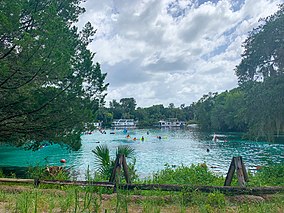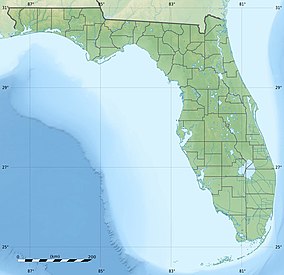Silver Glen Springs is a first-magnitude spring and the main attraction of the Silver Glen Springs Recreation Area of Ocala National Forest.[1][2] It lies at the east edge of the national forest.[3] It is about 2 miles north of the entrance of Juniper Creek,[4] and it is along the edge of the Big Scrub.[1] There is a short spring run that is about 0.75 miles long and goes to Lake George.[1][2][3]
| Silver Glen Springs Recreation Area | |
|---|---|
IUCN category V (protected landscape/seascape) | |
 Silver Glen Springs, August 2020 | |
| Location | Marion, Florida, United States |
| Coordinates | 29°14′48″N 81°38′37″W / 29.2468°N 81.6435°W |
| Area | 22 acres (8.9 ha) |
| Governing body | Ocala National Forest – Lake George Ranger District |
The site is managed by Ocala National Forest – Lake George Ranger District and run by a private concessioner.[3] It is a popular day use area as well as an archaeological site.[1]
History
editNative Americans inhabited the St. Johns River around 5000 years ago, evidenced by radiocarbon dating of shell mounds along the river.[5] Artifacts such as Stone Age tools, pottery, and other relics have been uncovered at Silver Glen Springs.[5]
Silver Glen was previously a large private campground.[4] Later, it gradually transformed into a wilderness setting.[4]
Description
editSixty-five million gallons of water a day come out from two spring vents.[3] At the southwest corner of the spring pool is a small spring vent called “Natural Well” which contains fish and the occasional manatee.[3] It is not accessible by water to protect the natural habitat, but can be seen from land.[3] Natural Well is 12–15 feet in diameter and 40 feet in depth.[5] The spring vent at the eastern part of the pool is 18 feet deep.[5] The spring pool is large and semicircular, measuring 200 feet north to south and 175 feet east to west.[5] The pool bottom is composed of sand and limestone with some aquatic grass.[5] The water is clear and cool at 72 degrees Fahrenheit.[4]
Sometimes large schools of striped bass travel from the lake to the headspring.[2] Also, tilapia can be seen going to the spring and building nests.[2] Mullet can be seen as well.[4] There is an immense cave system under the picnic area adjacent to the spring.[2]
The park has the Spring Boils Trail that goes through the woods and leads to a boardwalk that goes to several sand boils, where water bubbles up through the sand.[4] There is an old Native American mound east of the springhead, where Native American groups sometimes have ceremonies.[4]
The area around the springs are relatively isolated with some private hunt camps.[3] The Juniper Club is at the eastern entrance to the springs.[4] This all-male club owns three thousand acres of land in the area.[4]
Activities
editSilver Glen Springs is a very popular site with large crowds of visitors, especially on the weekends.[3] There is a fee to access the site.[3]
Snorkelers can see saltwater and freshwater fish in the same headspring pool.[2] No lifeguards are on duty.[3] Scuba diving and fishing in some areas are prohibited.[4] Canoe rentals are available.[3]
There is a picnic area with tables, charcoal grills, and a volleyball net.[3] A small general store provides some goods such as ice and volleyball rentals for the nearby volleyball area.[3] Restrooms are on site.[3]
The park does not permit overnight camping, only day use.[4]
In popular culture
editIn 1941, the movie company Metro-Goldwyn-Mayer arranged with the Juniper Club to film some scenes of The Yearling at their property. During the filming, a barge sank in Silver Glen and it can still be seen today.[4]
References
edit- ^ a b c d "Silver Glen Springs Recreation Area". Ocala National Forest. 2020-03-09. Retrieved 2020-09-13.
- ^ a b c d e f Stamm, D.R. (2008). The Springs of Florida: Text and Photographs. G - Reference, Information and Interdisciplinary Subjects Series. Pineapple Press. p. 75. ISBN 978-1-56164-418-6. Retrieved 2020-09-13.
- ^ a b c d e f g h i j k l m n Watson, M. (2015). Touring the Springs of Florida: A Guide to the State's Best Springs. Touring Hot Springs. Falcon Guides. p. 91. ISBN 978-1-4930-1449-1. Retrieved 2020-09-14.
- ^ a b c d e f g h i j k l McCarthy, K.M. (2008). St. Johns River Guidebook. G - Reference, Information and Interdisciplinary Subjects Series. Pineapple Press. p. 61. ISBN 978-1-56164-435-3. Retrieved 2020-09-13.
- ^ a b c d e f Norman, R.; Gallant, G. (2010). Ocala National Forest. Images of America. Arcadia Publishing Incorporated. ISBN 978-1-4396-4139-2. Retrieved 2020-09-14.

